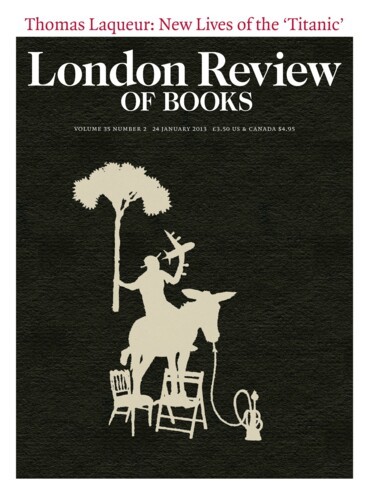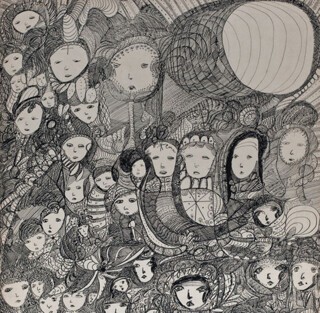Britain’s best-known Outsider artist is rarely seen in Britain. Until a couple of years ago, when the Whitworth Gallery in Manchester acquired some, you had to go to the Collection de l’Art Brut in Lausanne to find works by Madge Gill. The nine-metre-long paper scroll that was briefly on show in the second part of the Gill exhibition at the Nunnery Gallery in Bow (the third and final part is on until 31 January) is a mad marvel of black and red ink. For most of its length, black and white checkerboard patterns, paths, stripes and fences, strange pieces of aerial geometry, surround or hem in clusters of ethereal-looking women. The only areas not covered in ink or hatching are their pale, anxious faces. The women are jostled, muscled out by the solid shapes around them, as if deprived of air. (Or maybe they’re afraid of it: Gill seems to have had a horror of blank space on the page and towards the end of her life rarely left her house.) They are dressed in red coats and hats, red fading to pink, some clutching fans, some wearing fingerless black gloves revealing feathery fingers. Some have older faces weighted down by enormous, extravagant feathered hats or square pillar-box ones. They look like the confections of Aubrey Beardsley. Others are younger with wispy hair and what might be flowers tucked behind their ears: it’s hard to tell, because background and ornament blend into each other in a complex series of recurring forms.
One could imagine Gill designing fabrics for Liberty, but she wouldn’t have had any interest in that sort of thing, nor would she have been asked – she was an East End housewife who worked out of her own living room and bedroom. The scroll isn’t finished: further along, the women are drawn and their outfits coloured, but the spaces between them are filled with only basic cross-hatchings – there is no heavy blocking-in of black as in the early and more complete section. Further along still, the women are drawn but their coats aren’t coloured and the spaces between them are empty apart from some spindly spirals and a few irregular lines. In the exhibition the rest of the paper was rolled up – Newham Council, which owns much of Gill’s work, would only allow six of the scroll’s nine metres to be shown, to protect the rest – but apparently the rolled-up end is as fully drawn as the part on display. Presumably Gill found it harder to get at the middle of the scroll: she was working on a trestle table, a small section at a time, without the luxury of a studio space to spread it out in.
Gill made the scroll in 1949 at her house in Upton Park in East Ham, where she lived with her two sons; she had been making things like it for thirty years. She was born illegitimate in London in 1882; her mother had her fostered and she spent a few years in an orphanage before being sent to work on a farm in Canada. She came back to East London when she was 18, to live with her aunt Kate, a medium who held séances at home. Gill married Kate’s son (they didn’t get on) and had three sons, though one died. In 1919 she gave birth to a stillborn daughter. She became dangerously ill and complications caused her to lose the sight in one eye. On 5 March 1919, after her recuperation, Gill wrote that a spirit guide had started appearing to her, compelling her to make her work. She called the spirit Myrninerest – ‘my inner rest’ – and it was under her guidance that Gill created her pen and ink drawings and paintings on cardboard and paper as well as untreated calico rolls, many of them signed with Myrninerest’s name. She also knitted, and made rugs and dresses.
In 1922 Gill was briefly committed to a women’s clinic in Hove, where she allowed a doctor to see her drawings. The doctor sent them to the Society for Psychical Research, where they were pronounced to be ‘more of an inspirational than an automatic kind’. Then, in 1932, the Whitechapel Gallery started holding an annual East End Academy show. It invited work from anyone living less than ten miles east of the Aldgate Pump. Both Gill’s sons had drawings on display in the first exhibition, and it’s probable that they encouraged their mother to contribute something. She stole the show. The Times reported:
One of the most remarkable works in the exhibition – a work that would be remarkable in any exhibition, both in form and technically – is a pen and ink drawing on calico, measuring no less than 17ft by 5ft 6in., entitled Reincarnation by Mrs M.E. Gill. For convenient description, it is something between the work of modern Dutch and Belgian mystics and that of Mr Stanley Spencer.
She exhibited at the Whitechapel almost every year until 1947, and it was her work people came to see, spectacular drawings on calico at ever increasing sizes. There is a rumour that in 1947 she was offered a show in ‘an illustrious’ West End gallery. The story has it that she refused, fearing it would offend Myrninerest. She also turned down offers to buy her work, as if it wasn’t hers to sell, prompting an Evening Standard headline in 1939: ‘East End artist will not sell her work: 8ft carpet is worth £200.’
There was, naturally, much interest over the years in her guiding spirit, and Gill could be quite snappy about it: ‘All the time,’ she told one journalist, ‘I was in quite a normal state of mind and there was no suggestion of any “spirit” standing beside me.’ To another, Louise Morgan, a journalist who became a friend, she wrote that she wished she could be ‘normal’, and that every face she drew had significance – but she would never be drawn on what. The faces, of course, are the thing that people find so compelling about her work. Are they versions of her lost dead daughter, or representations of Myrninerest, or – as Roger Cardinal speculated when he made her calico The Crucifixion of the Soul one of the centrepieces of Outsiders, his genre-defining show at the Hayward in 1979 – ‘attempts to stabilise her own fragile being, as it were through fleeting snapshots’? It’s all very dramatic. But the faces often seem more playful, and less fearful, than any of this suggests. A drawing included in the first part of the exhibition in Bow (and reproduced here) shows a series of women of all imaginable types. Some are nuns with wimples and crosses, one is a queen; one has an Ancien Régime beauty spot and another a grand Gill hat. It’s drawing as a form of dressing-up: it’s fun as much as it’s eerie.
When she died in 1961, Gill’s house in Upton Park was crammed with thousands of pieces of her art – much of it stashed in cupboards and drawers and under her bed. Her surviving son, Laurie, donated several hundred of them to the local council, and Newham’s ‘art and heritage’ service has been keeping them in archival conditions ever since. The Nunnery Gallery is a small space, which made the three-part show necessary; the first exhibit was cleverly centred on a double bed with drawers under it, inside which a selection of her black and white postcards of spirals and checkerboards were displayed, overlapping one another in places to suggest the disarray of discovery, along with some of her writings. The current exhibit is strangely blank: the co-curator has chosen to show just nine small postcards – in order, he says, to ‘challenge’ the traditional idea of Outsider art and the usual mad profusion. You understand the impulse, but Gill sometimes made a dozen or more postcards a night. Mad profusion was what she was all about.
Send Letters To:
The Editor
London Review of Books,
28 Little Russell Street
London, WC1A 2HN
letters@lrb.co.uk
Please include name, address, and a telephone number.


